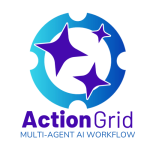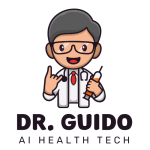Innovation in AI Health
A proprietary dual-layer architecture that combines relational empathy and technological rigor to create a safe, human, and contextualized decision-support tool for the patient.
Dual-Layer Architecture
To ensure safety and reliability in the healthcare sector, our approach orchestrates AI on two synergistic levels. Click on each level to explore the details.

Actiongrid Workflow
The strategic orchestration of AI Resources that acts as a "director" to manage entire processes and achieve complex goals.
DrGuido LLM Orchestrator
The multi-model intelligence "engine" that guarantees the quality and reliability of every single analysis, selecting the most suitable LLM.

Workflow Methodology
To manage complex processes to ensure verified, high-quality answers, eliminating the risk of hallucinations. This is achieved through a structured cycle (Analyze, Delegate, Generate, Validate) that governs the collaboration between agents, ensuring each phase of the process is controlled and the final result is reliable.

LLM Orchestrator
nspired by cutting-edge research like Google Research's AMIE (Articulate Medical Intelligence Explorer), this high-performance "engine" guarantees the quality of every analysis. The platform orchestrates a fleet of expert models, connecting to specialized healthcare LLMs like Google's MedGemma.
Intellectual Property
The creation of IP is our distinctive competitive advantage in the AI Health market. We have initiated the patenting process for methodologies that define a new standard in the human-machine relationship.
Actiongrid Workflow
A multi-agent system for the real-time orchestration of complex workflows, with advanced prompt customization for each AI Agent.
Empathetic Chain-of-Thought (E-CoT)
A revolutionary method that guides AI to generate authentic empathetic interactions by understanding the user's emotional state.
Confidence-Gated Negotiation Loop
An internal validation process that ensures reliability through a "negotiation" among expert models, guaranteeing a safe and clinically sound output.
Questions & Answers
How is your technology defensible against major players like Google, who are developing their own healthcare AI models (e.g., Med-PaLM)?
Our Intellectual Property does not lie in creating a foundational Large Language Model (LLM), but in the dual-layer orchestration architecture that governs them. While major players build the "engines," we build the "operating system" and "flight control system" specific to AI Health. Our patents, such as the Actiongrid Workflow and the Confidence-Gated Negotiation Loop, protect the process by which we make these powerful engines safe, reliable, and empathetic. This positions us as a strategic partner and a value-added layer, not as a direct competitor on foundational models.
Your "dual orchestration" sounds complex and expensive. How do you plan to manage scalability and computational costs?
The architecture is specifically designed for large-scale efficiency. The Dr. Guido LLM Orchestrator acts as an intelligent resource manager: for each task, it dynamically selects not the largest model, but the most efficient and effective one. This "Mixture-of-Experts" approach avoids using oversized models for simple tasks, drastically optimizing computational costs while ensuring maximum precision when needed. Scalability is inherent to its modular design.
Why is "relational empathy" a technological advantage (a "moat") and not just a UX feature?
Empathy, generated by our patentable Empathetic Chain-of-Thought (E-CoT) methodology, is a fundamental technological driver. In healthcare, an empathetic interaction increases patient trust, leading them to share more complete and accurate information. This high-quality data is the input that fuels our entire system, improving diagnostic accuracy and response relevance. Empathy creates a virtuous cycle: better interaction -> better data -> smarter AI. This is a "data moat" that is difficult to replicate.
What is the current status of your patents and what kind of real protection do they offer?
We have initiated the registration process and are in the "patent pending" phase for the three key methodologies. The protection they offer is procedural: we are not patenting an algorithm, but the method by which different AI agents collaborate (Actiongrid Workflow), generate empathy (E-CoT), and validate information (Confidence-Gated Negotiation Loop). This prevents a competitor from replicating our specific approach to safety and reliability, even if they were to use the same foundational LLMs.
Your technology relies on third-party models like MedGemma. How do you mitigate the risk of dependency on these providers?
Our anti-dependency strategy is our LLM Orchestrator itself. It is designed to be "model-agnostic." Its ability to manage a "fleet" of different models (commercial, open-source) allows us to not depend on a single provider. If a provider changes their terms of service, pricing, or if a better model emerges, we can integrate, replace, or rebalance the use of models without having to redesign the architecture. This flexibility is a fundamental strategic asset.
You claim to eliminate AI "hallucinations." How can you guarantee this in a high-risk sector like healthcare?
No AI system can promise 100% accuracy. However, our Confidence-Gated Negotiation Loop methodology is our most powerful risk mitigation mechanism. Instead of trusting a single model, the system orchestrates a "negotiation" among multiple virtual experts. A response is provided to the patient only after a cross-validation process has reached a predefined confidence threshold. This drastically reduces the probability of factual errors ("hallucinations"), a non-negotiable requirement for AI in a clinical context.
How does your technological architecture support your data strategy?
The architecture is the engine of our data strategy. The Actiongrid Workflow captures structured data on interactions and decision-making processes (e.g., which tool was used, which agent was delegated). The LLM Orchestrator captures the nuances of the dialogue. This combination provides us with a unique and rich dataset, which is not just a conversation log, but a structured map of how to solve health problems empathetically and safely. This data is the asset we use to continuously refine our IP.
Beyond the current architecture, what are the next two key milestones in your technology roadmap?
The first key milestone is completing the Medical Device Regulation (MDR) certification process for our platform, a crucial step for clinical validation and enterprise adoption. The second is expanding the capabilities of the LLM Orchestrator to include self-learning and autonomous optimization of the model "fleet," further reducing manual intervention and continuously improving performance.
How has the effectiveness of this "dual orchestration" been validated in the market?
Validation occurs on two fronts. Firstly, our B2C application, Dr. Guido, serves as our real-time R&D lab, demonstrating that our approach generates high engagement and trust from users. Secondly, we already have B2B commercial traction with clients who are integrating our Custom APIs. This validates the fundamental thesis: companies in the Health sector don't just want an "AI model," but an orchestrated, secure, and reliable solution to integrate into their systems.
